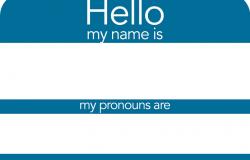Presenting our pronouns: When feminist politics pull in different directions

Davina Cooper explores an increasingly common practice in private, pubic and professional spaces.
Pronoun sharing has become an increasingly mainstream practice. Today, pronouns appear in automatic email signatures, in online meeting names, and pinned to clothing as companies like M&S and Asda offer pronoun badges to staff who want them. For some, this reflects the desirable normalisation of a new gender landscape. For others, it is an imposition. Many who criticise pronoun displays do so for conservative reasons – opposed to the reconfiguring of gender into a plural, flexible identification. But ambivalence or disengagement with the practice also comes from feminist others.
Talking with friends and colleagues, many are ambivalent. Like myself, they feel pulled by progressive arguments in different directions. This brief discussion is a reflection on these different tugs. Focusing on routine pronoun presentations in mixed public environments (rather than queer or trans ones), I want to suggest that, when it comes to a choice between displaying or not displaying whether we are “they”, “her”, “him”, or something else, there is no single right answer. Some may find this a cop-out (on both “sides” of the issue). But recognising dilemmatic issues on the left is important – not just for pronouns but for the many contexts where progressive arguments don’t cluster on one side. Dilemmatic issues generate ambivalence, equivocation, and sometimes agonising uncertainty. Here, deciding what to do – or simply doing it – may not take a single course but vary with context or in line with (or against) fluctuating political currents.
To explore the dilemmas surrounding pronoun display, I want to start with some reasons for doing it, and then turn to the progressive tugs, pulling people in different directions. As arguments in favour of displaying pronouns are well known, I will mention them briefly here.
Why people should display their pronouns
1.
If pronouns aren’t made explicit, some people will be misgendered. This falls unevenly. People with unexpected gender presentations, or those who identify as neither women nor men, are likely to be misgendered most. Thus, the hurt or discomfort falls heaviest on people whose gender is least protected and secure. Sara Ahmed describes how, ‘Those who appear to confound the senses, to create confusion (are you a boy or a girl, who are you, what are you?) are those who fail to reproduce a history.’ We might think of this history as both personal and societal.
Deliberately referring to someone with contrary pronouns is excluding, insulting, and at times, nativist – ushering in a “we were here first” politics, as the territory of gender categories gets claimed. Accidental misuse also holds up a mirror to societal assumptions – the misgendering, for instance, of androgynous-looking lesbians, the assumption that a couple who present themselves, in writing, as Ms and Dr are heterosexual.
2.
Presenting one’s pronouns should be done by everyone not just those liable to be misgendered. Otherwise, some people’s gender will be treated as novel or remarkable, while other people’s genders remain taken-for-granted and normalised. The discomfort some (non-trans) people feel on displaying their gender is a discomfort associated with naming something that has been able to remain unmarked. This is an unwarranted privilege held by those with conventional binary gender identities.
3.
Providing pronouns on an email signature or on an online conference platform can be an act of solidarity by those who don’t typically experience misidentification. It ensures it is not just those whose pronouns are challenged or incorrectly ascribed who must do the announcing work.
4
Widespread display and sharing of pronouns unsettles conventional gender norms in which stable pronouns are assumed to correspond with stable, singular subjectivities. Identifying pronouns at every seminar or meeting, or in the modifiable form of the virtual signature, enables people to identify several pronouns that they are happy with, for instance “him and they”, or “her and they”. It also makes constant amendment possible – a gender praxis that disrupts notions of gender as settled and fixed. Sonny Nordmarken writes, ‘Asking about a person’s pronouns indicates a queer understanding of gender (as unstable, nonbinary, changeable, complex, and open-ended).’
5
Sharing enacts the claim that we cannot know the right pronoun for someone else unless we are told. Everyone’s pronouns are uncertain, since they cannot be inferred from appearance, voice, body etc. Sociolinguist Lal Zimman writes, “Because the individual is framed … as the ultimate source of authority about their own gender, gender identity itself can only be defined in terms of the categories with which a person overtly aligns.” This severs gender from sexed embodiment. More radically, it may hollow gender out – at least as a descriptor of subjects. Gender loses its collectively shared content, since what is conveyed by a gender pronoun becomes personal, non-standardised, and constantly remade.
6
Displaying pronouns is a present-day strategy; an action with a purpose. It raises consciousness and resets people’s assumptions about each other and how they should behave. Once these shifts have been accomplished, pronoun display may become unnecessary.
***
For many, arguments like these in favour of presenting one’s pronouns are compelling, trumping any alternatives. And yet, there are also progressive reasons for hesitating. These hesitating-reasons don’t justify an organisation stopping or discouraging people from displaying their pronouns but explain, I think, why some individuals may choose not to do so or may feel uncertain. The requirement to present one’s pronouns is anchored in the importance placed on proper gender recognition. The risk, for some, is that this suggests gender should remain important going forward – that pronouns (if not their display) will remain integral infrastructure to the world we want to build and inhabit.
Ambivalence about pronoun display
1
Displaying our pronouns can suggest that gender is a positive attachment. If we feel alienated by our gender, an emerging assumption is that another gender may be the right one. But from a different feminist perspective, often knowing oneself to be she/ her (whether as trans or non-trans women) comes from being socially situated, addressed, and treated as women within mainstream society – and not in a good way. For many feminists, she/ her (or any other gender pronouns) are not what we choose to be.
If the call to publicly present our pronouns presumes a positive identification with gendered identities, how can we simultaneously identify the relationship as a critical one – disidentifying not only with the social category we are placed in (with all its costs and privileges) but also with the coercive gender system in which this categorising takes place? As a colleague put it, reflecting on pronoun display, “badges or email signatures to me seem to flatten the complexity of gender in a way that, ironically, does not make me feel particularly recognised.”
If we are alienated from the gender and gender system that situates and defines us, should we identify our gender differently – as “they”, for instance, or is this to jump ahead in ways that fail to acknowledge our current place? Pronoun display can seem a very present-oriented practice, bracketing off not only past gender identifications but future ones too. We may become another gender, but that is a pronoun, the convention implies, for another time (or space).
2
Gender is political – and being he/ him, they/ them, or she/ her are not equivalents. Some grassroots communities may use gender descriptors innovatively, counterculturally, even ironically, but this does not erase (indeed it takes place in relation to) the social subjectivities that dominant relations create and hold in place (or at least attempt to).
Since gender institutionalises power through the unequal norms, roles, relations, wealth, and labour associated with women and men, trans and non-trans, feminine and masculine, normative and other genders, pronouns are not equivalents. They aren’t different patterns of the same kind of cloth.
Expecting people to identify publicly with a gender pronoun, and treating different gender pronouns as equally valid, can suggest gender’s political character is simply a matter of who is included and recognised (and who, if anyone, is left out). But correct identification according to a gender pronoun category does not necessarily lead to respect, equality, or fairness. It simply means being recognised as a particular kind of person or thing. Focusing on pronoun accuracy can misleadingly imply that if we are ‘correctly’ categorised, other social justice benefits will follow.
3
Displaying pronouns speaks to a culture of individuation – not because of the stress placed on getting pronouns right, but as an act defined by the singular third person – the individual discussed or described by others (often in front of them). It is striking in English that a group of people of any gender are referred to in gender neutral terms. Thus, “pronouns” speaks to a concern about what individuals are saying or doing rather than the collective – even as getting a person’s pronouns right is about correctly referencing them at the level of the group.
Pronoun display, however, is also relational. It is about what others do having shared our pronouns with them, a point Abigail Saguy and Juliet Williams consider in their interesting article on the “singular they”. Some gender-critical feminists sometimes argue that pronoun sharing gives rise to compelled speech as people become obliged to concede to another person’s self-description. This isn’t the argument I want to advance. It isn’t that others are treated unreasonably in being expected to use someone’s self-identified pronoun, but to ask what follows the invitation or instruction. Unless gender is a formalist shell, telling people which pronoun to use, and making this process an important and public one, secures gender as a site of meaning making and action. This may not be immediate – knowing a retail worker is ‘she’ may not solicit forms of curtesy (grooming compliments, for instance) deemed inappropriate applied to a ‘he’, but it informs and nourishes the gendered imagination. Whether this is bad or not depends on whether gender seems an enriching dimension of progressive society going forward.
4
Declaring pronouns on badges and email signatures is also a short step, some may feel, to public displaying all our social locations – including our sexuality, ethnicity, religion, disability, and class. I’m reminded of a pinned badge in the mid-80s, which read, “how dare you presume I’m Christian?”.
The question was not intended to generate a new convention of ethno-religious identity-sharing but to oppose the over-inclusive embrace and normative supposition of hegemonic Christianity.
Are there good reasons to share our gender but not our positioning in other social relations of inequality? Convention may suggest yes. Gender is explicitly and routinely signalled in speech in ways that other social relations are not – although there are interesting instances of moves to change that, as in the Stockholm pre-school which started calling all children by the gender-neutral ‘hen’ or ‘friends’ (or by their name) as part of a broad move to resist gender stereotyping. Yet, while other social relations in Britain today may not be verbally confirmed, quite so frequently, in everyday speech acts, they are signalled in other ways: for instance, holiday greetings, such as “Happy Easter”, that mark the assumed universality or sharedness of a dominant Christian culture.
We could go on finding similarities and differences between gender and other social categories to justify or, conversely, invalidate pronoun-display. The trouble with this approach is that it can end up treating social categories as abstractions. The argument, sometimes made, that gender transitioning is analogous to age or race-based transitioning is a similar move. But gender, race, and age don’t just float around as mental iterations of a common template whose rationality holds fast across different contemporary categories. Histories of gender, race, age, and other social relations imprint on current politics. This makes the meaning of displaying one’s gender different from displaying one’s religion, for instance. This is something corporate retailers know. Despite the isomorphism that runs through organisational approaches to different social inequalities, it is gender badges rather than ethnic or religious display badges that are offered.
Should we move to “they”/ “them“?
Pronoun diversity prefigures, at least for some, what gender should become – a proliferate range of expressive identifications that exist non-hierarchically and non-relationally, where what it is to be he/ him, for instance, does not take its meaning from she/ her in any significant way. Here, differences between him, her, they, and other pronouns are more like the differences between rowing and badminton, or stamp and toy car collecting, than between working-class and bourgeoisie – as the Marxist feminist idea that “women” constitutes a sex-class would suggest.
For now, however, in conditions where pronouns signal statuses that are relational and very far from equal, one option is to use “they” as a general public pronoun for everyone. Feminists previously fought for “Ms”, arguing women’s marital status should not be a basis for differential honorifics between women; and for “chair” rather than “chairman” or “chairwoman”, countering sceptics’ claim that an inanimate sitting-object could not conduct a meeting. Use of “they” suggests that, in most contexts, people’s gender is and should be irrelevant to what is being said (about them).
Taking up the universal “they” counters the public marginalisation of those who specifically take up its terms since making pronouns public (though self-introduction, badge wearing, or signature) makes minority gender identities more visible. Of course, calling everyone “they” may seem to mask its specificity – the experiences of those living as genderless or nonbinary in a deeply gendered, binary world, akin to the naïve solidarity of the claim “we are all Jews” or “Ukrainians” or (not long ago) “Parisians”.
The universal “they” may also seem to obscure male status and power. Noting and attending to men’s gendered access to power, however, does not depend on pronoun usage. Making the singular “they” more general can also be a prefigurative practice – the anticipatory representation of a less gendered world as a way of moving towards it, where practicing the “they” is something more involved and socially ambitious than a semantic familiarity with the neutral singular third person.
In the meantime…
Progressive reasons exist for displaying one’s pronouns and for not doing so. This is important to recognise. Making one’s pronouns visible is a political intervention to redefine gender, severing or reshaping its relationship to sexed embodiment, and bringing the norms of alternative gender communities into the mainstream. It doesn’t rely on the inherent importance of pronouns but what their correct usage represents in societies which deny, police, and stigmatise gender transitioning. But holding back from pronoun display is a political intervention also. At its best (and it isn’t always that), non-performance may be a refusal to present oneself in gender terms, recognising gender as a regrettable, hierarchical structure that relies on and performs difference through power.
I have described pronoun display as a dilemmatic issue. As such, it poses a challenge for feminist, queer, and other progressive gender politics. Critical politics have long and powerful histories of exposing harm, demonstrating its presence when others cannot see it, and of showing what the right thing is to do – often (even usually) against the grain of common-sense action. But critical approaches are less comfortable when the right thing is not clearcut, when progressive arguments and analyses can be found dispersed across a field of action. At a personal and collective level, this can produce agonies of indecision. It also produces micropolitical forms of judgment about the right response.
In suggesting there are instances where the right progressive choice is not clearcut, deliberative virtues of respect, listening, and plurality surface, including in public discussion on displaying pronouns. However, when display gets represented as a personal choice, the undergirding politics can be flattened. These politics of gender’s present and future are important. Rather than approach them as the foundations on which acts of pronoun display sit, they can be seen as the rich webs that pronoun display and the different responses it produces give rise to, with their overlapping, divergent, sometimes colliding notions of what is being said and done when gender is practiced.
Thanks to friends and colleagues who shared their thoughts on earlier versions of this text, and to Ben Kanter for the main image.
Davina Cooper is a Research Professor in Law & Political Theory at King’s College London. Her work focuses on conflicts of cultural diversity, transformative concepts, and radical governance initiatives. She has written about gender and sexuality since 1988; chaired Haringey Women’s Committee from 1988-90; and was Director of the AHRC Research Centre for Law, Gender & Sexuality from 2005-2009. Between 2018-2022, she was PI on the Future of Legal Gender Project (https://futureoflegalgender.kcl.ac.uk/). Her most recent books are Everyday Utopias: The Conceptual Life of Promising Spaces (2014) and Feeling like a State: Desire, Denial and the Recasting of Authority (2019).
This first appeared on the LSE's Engenderings blog.


